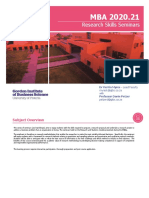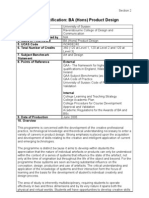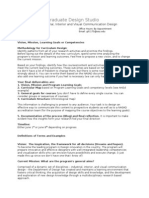Design 1245678
Design 1245678
Uploaded by
helia.amini86Copyright:
Available Formats
Design 1245678
Design 1245678
Uploaded by
helia.amini86Original Title
Copyright
Available Formats
Share this document
Did you find this document useful?
Is this content inappropriate?
Copyright:
Available Formats
Design 1245678
Design 1245678
Uploaded by
helia.amini86Copyright:
Available Formats
International Baccalaureate
Diploma Programme Subject Brief
Sciences:
Design technology—Standard level
First assessments 2016
The IB Diploma Programme (DP) is a rigorous, academically challenging and bal-
anced programme of education designed to prepare students aged 16 to 19 for
success at university and in life beyond. The DP aims to encourage students to be
knowledgeable, inquiring, caring and compassionate, and to develop intercultural
understanding, open-mindedness and the attitudes necessary to respect and evalu-
ate a range of viewpoints. Approaches to teaching and learning (ATL) within the DP
are deliberate strategies, skills and attitudes that permeate the teaching and learning
environment. In the DP students develop skills from five ATL categories: thinking,
research, social, self-management and communication.
To ensure both breadth and depth of knowledge and understanding, students must
choose at least one subject from five groups: 1) their best language, 2) additional lan-
guage(s), 3) social sciences, 4) experimental sciences, and 5) mathematics. Students
may choose either an arts subject from group 6, or a second subject from groups
1 to 5. At least three and not more than four subjects are taken at higher level (240
recommended teaching hours), while the remaining are taken at standard level (150
recommended teaching hours). In addition, three core elements—the extended
essay, theory of knowledge and creativity, action, service—
are compulsory and central to the philosophy of the programme.
These IB DP subject briefs illustrate four key course components.
I. Course description and aims III. Assessment model
II. Curriculum model overview IV. Sample questions
I. Course description and aims 4. an ability to understand and express ideas confidently and crea-
The Diploma Programme design technology course aims to develop tively using a variety of communication techniques through col-
internationally minded people whose enhanced understanding of laboration with others
design and the technological world can facilitate our shared guardian- 5. a propensity to act with integrity and honesty, and take responsi-
ship of the planet and create a better world. bility for their own actions in designing technological solutions to
problems
Inquiry and problem-solving are at the heart of the subject. DP design 6. an understanding and appreciation of cultures in terms of glob-
technology requires the use of the design cycle as a tool, which pro- al technological development, seeking and evaluating a range of
vides the methodology used to structure the inquiry and analysis of perspectives
problems, the development of feasible solutions, and the testing and 7. a willingness to approach unfamiliar situations in an informed man-
evaluation of the solution. A solution can be defined as a model, proto- ner and explore new roles, ideas and strategies to confidently artic-
type, product or system that students have developed independently. ulate and defend proposals
8. an understanding of the contribution of design and technology to
DP design technology achieves a high level of design literacy by the promotion of intellectual, physical and emotional balance and
enabling students to develop critical-thinking and design skills, which the achievement of personal and social well-being
they can apply in a practical context. While designing may take various 9. empathy, compassion and respect for the needs and feelings of
forms, it will involve the selective application of knowledge within an others in order to make a positive difference to the lives of others
ethical framework. and to the environment
10. skills that enable them to reflect on the impacts of design and tech-
Through the overarching theme of the nature of design, the aim of the nology on society and the environment in order to develop their
DP design technology course is to enable students to develop: own learning and enhance solutions to technological problems.
1. a sense of curiosity as they acquire the skills necessary for inde-
pendent and lifelong learning and action through inquiry into the
technological world around them
2. an ability to explore concepts, ideas and issues with personal, local
and global significance to acquire in-depth knowledge and under-
standing of design and technology
3. initiative in applying thinking skills critically and creatively to identi-
fy and resolve complex social and technological problems through
reasoned ethical decision-making
© International Baccalaureate Organization 2014
International Baccalaureate® | Baccalauréat International® | Bachillerato Internacional®
II. Curriculum model overview 3. Construct, analyse and evaluate:
• design briefs, problems, specifications and plans
Component Recommended • methods, techniques and products
teaching hours • data, information and technological explanations.
Core 90 4. Demonstrate the appropriate research, experimentation, model-
1. Human factors and ergonomics 12 ling and personal skills necessary to carry out innovative, insight-
2. Resource management and sustainable 22 ful, ethical and effective designing.
production
3. Modelling 12
4. Raw material to final product 23 Assessment at a glance
5. Innovation and design 13 Type of Format of Time Weighting
6. Classic design 8 assessment assessment (hours) of final
Practical work 60 grade (%)
Design project 40 External 2.25 60
Group 4 project 10
Teacher-directed activities 10 Paper 1 Multiple-choice questions 0.75 30
on core material
Paper 2 Data-based, short-answer, 1.5 30
The group 4 project and extended-response
The group 4 project is a collaborative activity where students from dif- questions on core material
ferent group 4 subjects, within or between schools, work together. It al-
Internal 40 40
lows for concepts and perceptions from across disciplines to be shared
while appreciating the environmental, social and ethical implications Design Individual design project 40 40
of science and technology. It can be practically or theoretically based project
and aims to develop an understanding of the relationships between
scientific disciplines and their influence on other areas. The emphasis is
on interdisciplinary cooperation and the scientific processes. IV. Sample questions
• Which phrase best reflects the philosophy of the circular
economy? (Paper 1)
III. Assessment model A. Cradle to cradle
The assessment objectives for design technology reflect those parts B. Cradle to grave
of the aims that will be formally assessed either internally or externally. C. Made to be made again
Wherever appropriate, the assessment draws upon environmental and D. Take, make, dispose
technological contexts and identify the social, moral and economic ef-
fects of technology. It is the intention of the design technology course • Explain how the use of “design for the environment” software
that students are able to fulfill the following assessment objectives: assists designers in choosing materials. (Paper 2)
1. Demonstrate knowledge and understanding of:
• facts, concepts, principles and terminology • Discuss why the use of thermoplastic renders a product green but
• design methodology and technology not sustainable. (Paper 2)
• methods of communicating and presenting technological
information.
2. Apply and use:
• facts, concepts, principles and terminology
• design methodology and technology
• methods of communicating and presenting technological
information.
About the IB: For over 40 years the IB has built a reputation for high-quality, challenging programmes of education that develop internationally
minded young people who are well prepared for the challenges of life in the 21st century and able to contribute to creating a better, more
peaceful world.
For further information on the IB Diploma Programme, and a complete list of DP subject briefs, visit: http://www.ibo.org/diploma/.
Complete subject guides can be accessed through the IB online curriculum centre (OCC) or purchased through the IB store: http://store.ibo.org.
For more on how the DP prepares students for success at university, visit: www.ibo.org/recognition or email: recognition@ibo.org.
You might also like
- Hands-On Science and Technology for Ontario, Grade 3: An Inquiry ApproachFrom EverandHands-On Science and Technology for Ontario, Grade 3: An Inquiry ApproachNo ratings yet
- College of Architecture and Fine Arts: Olytechnic Niversity of The HilippinesDocument5 pagesCollege of Architecture and Fine Arts: Olytechnic Niversity of The HilippinesTiara OyardoNo ratings yet
- Igcse DT BookletDocument124 pagesIgcse DT BooklethassanhafezNo ratings yet
- Corporate Scholarship GuideDocument17 pagesCorporate Scholarship GuideAsisclo CastanedaNo ratings yet
- Design Technology HlDocument2 pagesDesign Technology Hlatil celikNo ratings yet
- Seminar Log BookDocument17 pagesSeminar Log Booklankesandesh2003No ratings yet
- Unit-1 FomDocument39 pagesUnit-1 Fomlokeshappalaneni9No ratings yet
- Qualitative Research DesignDocument3 pagesQualitative Research DesignJandri Vay SianturiNo ratings yet
- 221603404 Design ThinkingDocument4 pages221603404 Design Thinkingrodajer990No ratings yet
- Lecture 1.1 Introduction To Design Thinking CourseDocument26 pagesLecture 1.1 Introduction To Design Thinking Courseyann olivierNo ratings yet
- LecturePlan BC201 23CAP-103Document6 pagesLecturePlan BC201 23CAP-103itsmepema21No ratings yet
- Second Year Mini Project Handbook: Vidyavardhini's College of Engineering & TechnologyDocument22 pagesSecond Year Mini Project Handbook: Vidyavardhini's College of Engineering & Technologyvrushali patilNo ratings yet
- Second Year Mini Project Handbook: Vidyavardhini's College of Engineering & TechnologyDocument22 pagesSecond Year Mini Project Handbook: Vidyavardhini's College of Engineering & Technologyvrushali patilNo ratings yet
- Unit-4 FomDocument44 pagesUnit-4 Fomlokeshappalaneni9No ratings yet
- Capstone Project OutlineDocument3 pagesCapstone Project OutlineArpana MurugappanNo ratings yet
- Wind Chimes TM Program 2010Document8 pagesWind Chimes TM Program 2010Erich ManteiNo ratings yet
- Operating SystemDocument6 pagesOperating Systemsahilrajput821831No ratings yet
- Design ThinkingDocument2 pagesDesign Thinkingshubhampatil110805No ratings yet
- CPE 310 - Method of ResearchDocument17 pagesCPE 310 - Method of ResearchRomano GabrilloNo ratings yet
- Global Perspective Lesson PlanDocument5 pagesGlobal Perspective Lesson Planhira yaqoobNo ratings yet
- BankingE CommerceDocument88 pagesBankingE CommerceAbishNo ratings yet
- Research 2020.21 Outline PDFDocument12 pagesResearch 2020.21 Outline PDFCharles MaherNo ratings yet
- InSS6121 Research Methods for ISS Course Outline 2024Document3 pagesInSS6121 Research Methods for ISS Course Outline 2024hewan.gse-2132-17No ratings yet
- International Baccalaureate Diploma Programme Subject Brief: Sciences: Biology-Standard LevelDocument2 pagesInternational Baccalaureate Diploma Programme Subject Brief: Sciences: Biology-Standard Levelfunction_analysisNo ratings yet
- Instrumentation System DesignDocument138 pagesInstrumentation System DesignSS Tripathy100% (1)
- Design and Technology: Programme of Study For Key Stage 3 and Attainment TargetDocument10 pagesDesign and Technology: Programme of Study For Key Stage 3 and Attainment Targetapi-19768570No ratings yet
- Cecyte 1st Semester - Information TechnologyDocument83 pagesCecyte 1st Semester - Information TechnologyScribdTranslationsNo ratings yet
- RCA Fashion MA Programme Specifications 2022 23Document8 pagesRCA Fashion MA Programme Specifications 2022 23Mash FamilyNo ratings yet
- MYP Year 1, AdvertisementsDocument5 pagesMYP Year 1, AdvertisementsyouengNo ratings yet
- Myp 10Document51 pagesMyp 10Thomas Adam Johnson100% (4)
- M.SC., Computer ScienceDocument80 pagesM.SC., Computer ScienceSangeetha B SNo ratings yet
- Characteristics of A Good DesignerDocument2 pagesCharacteristics of A Good DesignerSadia Jamal SiddiquiNo ratings yet
- Programme Specification: BA (Hons) Product Design: Faculty of Design Definitive Document: 21 July 2006Document20 pagesProgramme Specification: BA (Hons) Product Design: Faculty of Design Definitive Document: 21 July 2006lisaconnollyNo ratings yet
- NBA AwarenessDocument31 pagesNBA Awarenessxyz boyNo ratings yet
- ISL Leadership Curriculum Book_Year 2022-23Document52 pagesISL Leadership Curriculum Book_Year 2022-23rohocarroNo ratings yet
- EBS217 Designing Instructional Materials Using ICTDocument215 pagesEBS217 Designing Instructional Materials Using ICTachiaaesther963No ratings yet
- M.SC., Data ScienceDocument128 pagesM.SC., Data ScienceBrijesh PandeyNo ratings yet
- CB3021Document6 pagesCB3021Alex ZhangNo ratings yet
- 2020 AR134 1 Syllabus ModDocument8 pages2020 AR134 1 Syllabus ModRenzel RazonNo ratings yet
- Olytechnic Niversity of The Hilippines: Graduate School Master in Information TechnologyDocument6 pagesOlytechnic Niversity of The Hilippines: Graduate School Master in Information TechnologyDaisy BrilloNo ratings yet
- Design: PHD Yearbook - 2018Document13 pagesDesign: PHD Yearbook - 2018Aleksandar MihajlovićNo ratings yet
- Design Products Specification 2018-19Document15 pagesDesign Products Specification 2018-19EduardoNo ratings yet
- COM RES Outcomes-Based SyllabusDocument9 pagesCOM RES Outcomes-Based SyllabusGWENETHA Y PUSTANo ratings yet
- Khung Chuong Trinh DT 8540204 2024 BKDocument5 pagesKhung Chuong Trinh DT 8540204 2024 BKlinhaipromptNo ratings yet
- 01.) Lab Manual - OS - 22 - 23 - UpdatedDocument67 pages01.) Lab Manual - OS - 22 - 23 - UpdatedDrishya TomarNo ratings yet
- Educational TechnologyDocument10 pagesEducational TechnologyKimalin SatudNo ratings yet
- HSC Mdpprogram 2015Document16 pagesHSC Mdpprogram 2015api-322152156No ratings yet
- Improving_Learners_Design_Thinking_in_InformationDocument6 pagesImproving_Learners_Design_Thinking_in_InformationMichael Gaming FabNo ratings yet
- Final Manual SampleDocument8 pagesFinal Manual Samplesmartboyy044No ratings yet
- Graduate Design StudioDocument2 pagesGraduate Design Studioapi-27326246No ratings yet
- 222.453 VCD Research & Development: Workbook, Research Summary and AbstractDocument1 page222.453 VCD Research & Development: Workbook, Research Summary and Abstractapi-25885843No ratings yet
- Technology For Teaching and Learning IIDocument2 pagesTechnology For Teaching and Learning IIapi-750521600No ratings yet
- Design Thinking - Jan 2023Document6 pagesDesign Thinking - Jan 2023SanchuNo ratings yet
- CSPC 109 - Course SyllabusDocument5 pagesCSPC 109 - Course SyllabusjanangfrigillanaNo ratings yet
- MYP Year 5Document5 pagesMYP Year 5youengNo ratings yet
- MBA 570D SP 2021 EzingaDocument7 pagesMBA 570D SP 2021 EzingahuzhuoNo ratings yet
- LecturePlan BC201 22CAP-306Document5 pagesLecturePlan BC201 22CAP-306blackcyberpiratesNo ratings yet
- MATH142-1 AY 2022-2023 SyllabusDocument10 pagesMATH142-1 AY 2022-2023 SyllabusZedric Mhiles VitugNo ratings yet
- FINAL EXAM ESP LESSON PLAN AND LESSON DEVELOPMENT ANDITA APRILIASARIDocument9 pagesFINAL EXAM ESP LESSON PLAN AND LESSON DEVELOPMENT ANDITA APRILIASARIanditaagrandeeNo ratings yet
- Teaching Research in Design: Guidelines for Integrating Scientific Standards in Design EducationFrom EverandTeaching Research in Design: Guidelines for Integrating Scientific Standards in Design EducationNo ratings yet
- Project-Based Learning Tasks for Common Core State Standards, Grades 6 - 8From EverandProject-Based Learning Tasks for Common Core State Standards, Grades 6 - 8No ratings yet
- Durga Kumari ReportDocument6 pagesDurga Kumari ReportHarshit RajNo ratings yet
- Math Q1Document23 pagesMath Q1ANNIE SY SUNo ratings yet
- LEARNING PLAN in English (Grade 10) I. OUTCOMES: at The End of The Lesson, Students Must Be Able ToDocument10 pagesLEARNING PLAN in English (Grade 10) I. OUTCOMES: at The End of The Lesson, Students Must Be Able ToJessa Mae Lig-angNo ratings yet
- Test Bank For Educational Psychology 2nd Edition 2nd EditionDocument7 pagesTest Bank For Educational Psychology 2nd Edition 2nd EditionDane Stone100% (42)
- DLL - Mapeh 3 - Q4 - W1Document4 pagesDLL - Mapeh 3 - Q4 - W1shyfly21No ratings yet
- Nutrition Modules Wellness Portfolio Learning Principles Choose Wellness CampusDocument55 pagesNutrition Modules Wellness Portfolio Learning Principles Choose Wellness Campusjomel nazarenoNo ratings yet
- 1 10 Speech Etiquette Consequences and RulesDocument7 pages1 10 Speech Etiquette Consequences and Rulesapi-255604476No ratings yet
- RRB AlpDocument55 pagesRRB AlpROHIT MARBHALNo ratings yet
- Learning About PeaceDocument5 pagesLearning About PeaceFernanda AzevedoNo ratings yet
- The Lost GenerationDocument2 pagesThe Lost GenerationVINOTININo ratings yet
- Template RPH Bahasa InggerisDocument1 pageTemplate RPH Bahasa Inggeriszleo86_27No ratings yet
- Section7 Subjects 090712070038 Phpapp01Document130 pagesSection7 Subjects 090712070038 Phpapp01raluqu1No ratings yet
- Islamabad Model College For Girls Shalimar F-74Document1 pageIslamabad Model College For Girls Shalimar F-74ADIL DURRANI100% (1)
- Ota MentorDocument5 pagesOta Mentorapi-724706240No ratings yet
- Student Satisfaction: A Method For Exploring Quality Factors WithinDocument8 pagesStudent Satisfaction: A Method For Exploring Quality Factors WithinFann YinNo ratings yet
- ITEC-75 TechnopreneurshipDocument10 pagesITEC-75 TechnopreneurshipRitch Banate100% (1)
- Rica Reflection Competency 4Document2 pagesRica Reflection Competency 4api-296624078No ratings yet
- Contemporary Week 3 DLLDocument3 pagesContemporary Week 3 DLLMae Jane Aguilar100% (1)
- Curriculum For One Year B.Ed. (Secondary) Programme-National Council For Teacher Education (NCTE)Document33 pagesCurriculum For One Year B.Ed. (Secondary) Programme-National Council For Teacher Education (NCTE)rajendra kumar devarapalliNo ratings yet
- Direct Instruction Lesson Plan TemplateDocument3 pagesDirect Instruction Lesson Plan Templateapi-456316114No ratings yet
- Grade 2 Narrative Writing PromptsDocument3 pagesGrade 2 Narrative Writing PromptsDavid50% (2)
- M.vijay GroupDocument4 pagesM.vijay GrouprtdNo ratings yet
- Annual Implementation Plan 2019-2020Document8 pagesAnnual Implementation Plan 2019-2020Marcela R. CollantesNo ratings yet
- DYP Induction BookletDocument24 pagesDYP Induction BookletdypcopakurdipuneNo ratings yet
- Resume Profile: Queen Munyiva Musyoka Cell Phone:0722 879 480Document4 pagesResume Profile: Queen Munyiva Musyoka Cell Phone:0722 879 480Anonymous u06Ho6vvNo ratings yet
- Contoh e RekodDocument2 pagesContoh e RekodLatifah A GhaniNo ratings yet
- Course OutlineDocument4 pagesCourse Outlineabu.kakon.241No ratings yet
- Mnemonic Strategies: EducationalDocument6 pagesMnemonic Strategies: EducationalmaulidinaNo ratings yet
- Research HHDocument10 pagesResearch HHCloeNo ratings yet

























































































